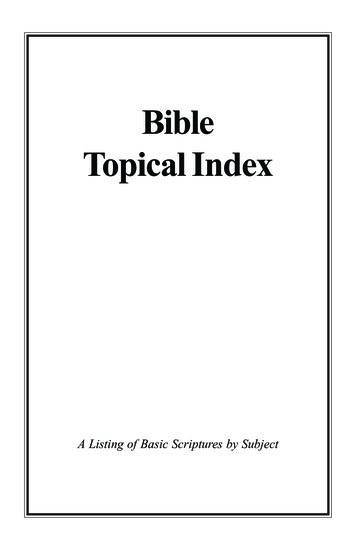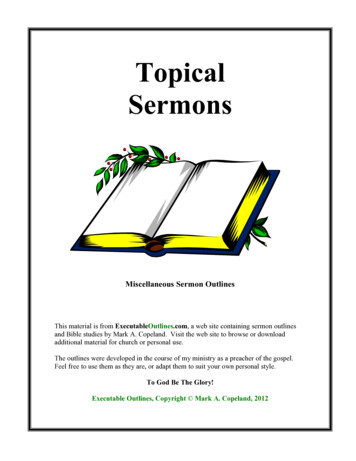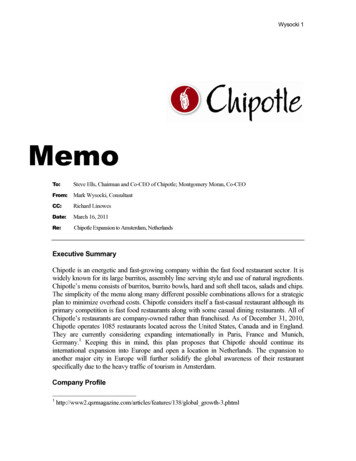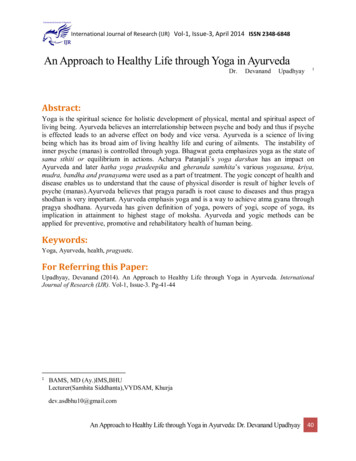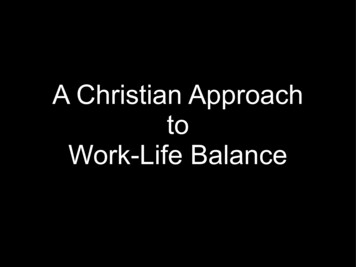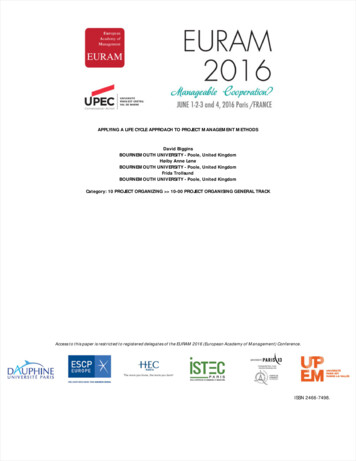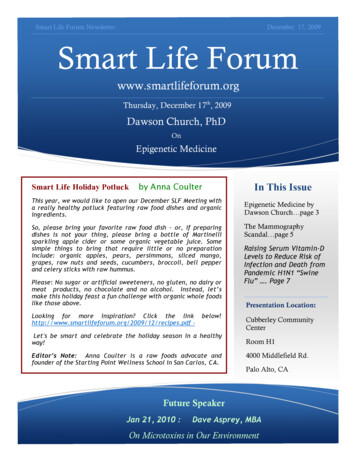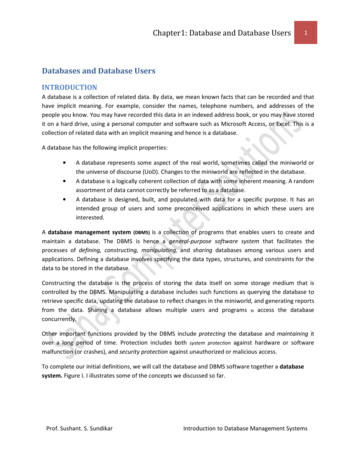
Transcription
Slide 1A Topical Approach toLife-Span Development 6eChapter One:IntroductionJohn W. Santrock 2012 The McGraw-Hill Companies, Inc. All rights reserved.
Slide 2The Life-Span Perspective The Importance of Studying Life-SpanDevelopment Characteristics of the Life-Span Perspective The nature of development 2012 The McGraw-Hill Companies, Inc. All rights reserved.
Slide 3The Life-Span Perspective How do we define development?o The pattern of movement or change thatbegins at conception and continues throughthe human life span. Life span Life expectancy 2012 The McGraw-Hill Companies, Inc. All rights reserved.
Slide 4Importance of Studying Life-SpanDevelopment Parenting/educating Nursing Gain insight about your own developmentalhistory, and know what to expect in the future. Developmental myths and misconceptions 2012 The McGraw-Hill Companies, Inc. All rights reserved.
Slide 5Characteristics of the �� Contextual– Growth,Maintenance,and Regulation ofloss– Co-construction ofbiology, culture, andthe individual 2012 The McGraw-Hill Companies, Inc. All rights reserved.
Slide 6The Nature of DevelopmentFigure 1.5 - Processes in Development 2012 The McGraw-Hill Companies, Inc. All rights reserved.
Slide 7Nature of Development Periods of developmento Time frame with certain characteristic features––––Prenatal PeriodInfancyEarly childhoodMiddle and latechildhood––––AdolescenceEarly adulthoodMiddle adulthoodLate adulthood 2012 The McGraw-Hill Companies, Inc. All rights reserved.
Slide 8Nature of Development Conceptions of age– Chronological age: Number of years elapsedsince person’s birth– Biological age: In terms of biological health– Psychological age: One’s adaptive capacities– Social age: Social roles and expectations relatedto one’s age 2012 The McGraw-Hill Companies, Inc. All rights reserved.
Slide 9Nature of Development Developmental issues– Nature and nurture Inheritance or environment?– Stability and change Traits and characteristics; capacity for change?– Continuity and discontinuity Gradual or abrupt changes in development? 2012 The McGraw-Hill Companies, Inc. All rights reserved.
Slide 10Theories of Development Theory: Interrelated set of ideas that helps toexplain data, make predictions Hypotheses: Assertions or predictions, oftenderived from theories that can be tested 2012 The McGraw-Hill Companies, Inc. All rights reserved.
Slide 11Theories of DevelopmentOverview Psychoanalytic theoriesCognitive theoriesBehavioral and social cognitive theoriesEthological theoryEcological theory 2012 The McGraw-Hill Companies, Inc. All rights reserved.
Slide 12Theories of Development Psychoanalytic theorieso Freud’s theory Development is primarily unconscious, heavy withemotion Behavior is surface characteristic of development Analyze symbolic meanings of behavior and deep innerworkings of the mind for true meaning of development Early childhood experiences stressed (ages 1-5) 2012 The McGraw-Hill Companies, Inc. All rights reserved.
Slide 13Figure 1.10 – FreudianPsychosexual Developmental StagesCriticisms: overemphasized sexual instincts, unconscious is more important today 2012 The McGraw-Hill Companies, Inc. All rights reserved.
Slide 14Theories of Development Erikson’s psychosocial theory– Primary motive for human behavior is social;desire to affiliate with others– Developmental changes throughout life span– Experiences at all ages are important 2012 The McGraw-Hill Companies, Inc. All rights reserved.
Erikson’s Eight Life-Span StagesSlide 15Criticisms: stages have positive/negative poles, crisis in each stage needs resolution 2012 The McGraw-Hill Companies, Inc. All rights reserved.
Slide 16Theories of Development Cognitive theories– Emphasize conscious thoughts– Three major theories Piaget’s cognitive development Vygotsky’s sociocultural cognitive theory Information processing theory 2012 The McGraw-Hill Companies, Inc. All rights reserved.
Slide 17Theories of Development Piaget’s cognitive developmental theory– Children actively construct their knowledge– Each of the four stages Age-relatedHas a distinct way of thinkingHas different way of understanding the worldChild’s cognition is “qualitatively” different 2012 The McGraw-Hill Companies, Inc. All rights reserved.
Slide 18Figure 1.12 - Piaget’s Four Stages ofCognitive Development 2012 The McGraw-Hill Companies, Inc. All rights reserved.
Slide 19Theories of Development Vygotsky’s sociocultural cognitive theory– Children actively construct their knowledge– Culture and social interaction guide cognitivedevelopment Learning to use inventions of society Learning from social interactions with more skilled adultsand peers Interaction creates tools to adapt to culture 2012 The McGraw-Hill Companies, Inc. All rights reserved.
Slide 20Theories of Development Information-Processing theory– Brain is compared to computer’s hardware– Cognition is viewed as computer software– Individuals acquire increasingly complexinformation– Thinking: perceive, encode, represent, store, andretrieve information– Good strategies: important to development 2012 The McGraw-Hill Companies, Inc. All rights reserved.
Slide 21Theories of Development Behavioral and social cognitive theories– Behaviorism: Scientific studies can only be basedon direct observations and measures– Development is observable behavior Learned from experiences/environment Development does not occur in stages; advocatescontinuity 2012 The McGraw-Hill Companies, Inc. All rights reserved.
Slide 22Theories of Development Skinner’s operant conditioning– Consequences, rewards and punishment, shapebehavior No emphasis on thoughts, feelings– Development is pattern of behavioral changes Modifying environment produces change Changes determined by consistency experiences,rewards or punishments 2012 The McGraw-Hill Companies, Inc. All rights reserved.
Slide 23Theories of Development Bandura’s social cognitive theory– Behavior, environment, and cognition are key todevelopment– Behavior is learned through observation andimitating (modeling)– Behavior of others is cognitively evaluated,strategies created for successful learning 2012 The McGraw-Hill Companies, Inc. All rights reserved.
Slide 24Figure 1.13 - Bandura’s Social CognitiveModel 2012 The McGraw-Hill Companies, Inc. All rights reserved.
Slide 25Theories of Development Ethological theory– Emphasis on biology and sensitive periods ofdevelopment,– Lorenz: Imprinting Animals’ rapid, innate learning process involving“attachment” Critical period is early in life 2012 The McGraw-Hill Companies, Inc. All rights reserved.
Slide 26Theories of Development Ethological theory– Bowlby Used ideas of Lorenz“Attachment” determines developmentPositive and secure, negative and insecureSensitive period is in infancy 2012 The McGraw-Hill Companies, Inc. All rights reserved.
Slide 27Theories of Development Ecological theory (environmental factors)– Bronfenbrenner’s view that developmentinfluenced by five environmental system tem 2012 The McGraw-Hill Companies, Inc. All rights reserved.
Figure 1.14 - Bronfenbrenner’s EcologicalTheorySlide 28 2012 The McGraw-Hill Companies, Inc. All rights reserved.
Slide 29Theories of Development Eclectic theoretical approach– Life-span development is complex– Each theory has contribution to understandingdevelopment Selects from best features of each– A mistake to rely on only one theory 2012 The McGraw-Hill Companies, Inc. All rights reserved.
Slide 30Research in Life-Span DevelopmentResearch Designs/types: Correlational research Experimental research Descriptive research 2012 The McGraw-Hill Companies, Inc. All rights reserved.
CorrelationThe extent to which two factors vary together,and thus of how well one factor predicts the other.For example:Length of marriage correlates with hair loss in Dr. KnightonThe greater the number of Facebook friends,the less time was spent studying
Correlation Coefficient The correlation coefficient is a number representing how closelyand in what way two variables correlate (change together). The direction of the correlation can be positive (both variablesincrease together) or negative (as one increases, the otherdecreases). The strength of the relationship, how tightly, predictably they varytogether, is measured in a number that varies from 0.00 to /- 1.00.Guess the Correlation CoefficientsHeight vs. shoesizeYears inschool vs.years in jailHeight vs.intelligenceClose to 1.0Close to-1.0Close to0.0(strong positivecorrelation)(strong negativecorrelation)(no relationship,no correlation)
Slide 33If we find a correlation, whatconclusions can we drawfrom it?Let’s say we find thefollowing result:there is a positivecorrelation between twovariables, ice cream sales, and rates of violent crimeHow do we explain this? 2012 The McGraw-Hill Companies, Inc. All rights reserved.
Slide 34Correlation is not Causation! 2012 The McGraw-Hill Companies, Inc. All rights reserved.
Slide 35So how do we find out about causation? Byexperimentationa researchmethod in whichthe investigatormanipulates onevariable undercarefullycontrolledconditions, andobserves whetherany changesoccur in a secondvariable as aresult The depression/selfesteem example:trying interventionsthat improve selfesteem to see if theycause a reduction indepression 2012 The McGraw-Hill Companies, Inc. All rights reserved.
Slide 36Naming the variablesThe variable we are able to manipulateindependently of what the other variables aredoing is called the independent variable (IV).The variable we expect to experience a changewhich depends on the manipulation we’redoing is called the dependent variable (DV). If pregnant women could change the sleeping patternsof their newborn babies by meditating duringpregnancy: Meditation Cause Independent Variable Sleeping patterns Effect Dependent Variable 2012 The McGraw-Hill Companies, Inc. All rights reserved.
Two Groups If we manipulate a variable in an experimentalgroup of people, and then we see an effect, how dowe know the change would have happened anyway? We solve this problem by comparing this group to acontrol group, a group that is the same in every wayexcept the one variable we are changing.How to makesure the controlgroup is reallyidentical inevery way to theexperimentalgroup?By using randomassignment:randomly selectingsome studyparticipants to beassigned to thecontrol group orthe experimentalgroup.
Slide 38Figure 1.18 - Principles of ExperimentalResearch 2012 The McGraw-Hill Companies, Inc. All rights reserved.
Slide 39Descriptive research Survey/interviewNaturalistic and Laboratory observationsStandardized testCase study Focus on aspects of individual’s life Unique, cannot be duplicated Physiological measures Blood tests, MRI 2012 The McGraw-Hill Companies, Inc. All rights reserved.
Slide 40Research in Life-Span Development Time Span of Research– Cross-sectional approach Compares different age groups at the same time on avariety of dependent variables– Longitudinal approach Studies same group over long period of time– Anger and heart disease 2012 The McGraw-Hill Companies, Inc. All rights reserved.
Slide 41 https://www.eztestonline.com/868274/index1.tpx 2012 The McGraw-Hill Companies, Inc. All rights reserved.
Research in Life-Span Development Time Span of Research –Cross-sectional approach Compares different age groups at the same time on a variety of dependent variables –Longitudinal approach Studies sam
